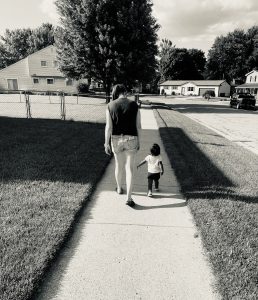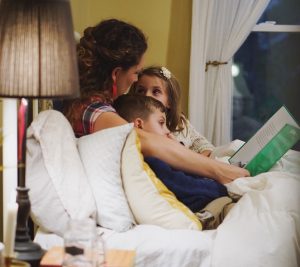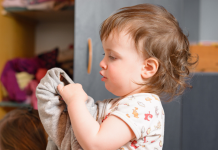Last month, in Raising Anti-Ableist Kids Part 1, I shared a list of my family’s favorite disability-inclusive books. Hopefully you had a chance to check some of them out.
Part of raising good humans includes fostering anti-ableism in our children. By reading disability-inclusive books, we create opportunity for our children to see and learn about all different kinds of disabilities. We can’t stop there though – we also need to talk about disability and do so in a way that is honest and respectful. Here are some tips for having conversations with your kids about disability.

Be Mindful of the Language You Use
This is simple and incredibly difficult at the same time. Words matter. Many health and disability-related words are used incorrectly in everyday conversation. Try to avoid using these words casually:
- Manic: For example, “Manic Monday”
- Bipolar: I hear the weather in Michigan described as bipolar pretty regularly.
- OCD: Being detail-oriented or liking things organized is not the same as having OCD.
- Mentally ill/psychotic: We cannot diagnose someone as mentally ill if we’ve never met them and are not qualified to clinically evaluate them. A person doing something violent does not mean they have a mental illness. Trying to explain away violence with mental illness is incredibly harmful and stigmatizing to mental health overall
- ADD/ADHD: Having a lot of energy or having difficulty focusing is not the same thing as having a condition like ADD or ADHD.
We want to avoid talking about disability in a way that implies limits or abnormality:
- Instead of “wheelchair bound,” try “wheelchair user”
- Avoid saying that someone “suffers from” a particular health condition or disability.
- The opposite of “disability” is not “normal.” People with disabilities are normal people, just like everyone else in the community. Instead, try “able-bodied” or “person without a disability.”
There are also some words that should never be used:
- Retarded: There is absolutely no situation in which it’s okay to use the word retarded. Ever. Even if the word is used in reference to something other than disability, it is still wildly offensive.
- Cripple: While some people with disabilities may use this word to describe themselves, it’s considered derogatory when coming from a non-disabled person.
- Slow/dumb: We should never talk about a person’s cognitive or intellectual capacity using words like these. If referring to a condition that a person has, we would say that they have an intellectual disability.
Being mindful of our language is incredibly important when we talk about disability.
Talking About Disability Should Be Part of Everyday Conversation
Talk about disability that you see in books.
Last month I shared a list of disability-inclusive books. If you check any out, talk about what you see. This is a great way to practice in a low-stress environment and is much easier than when your kiddo loudly asks you in public about a person using a wheelchair two feet away. Here are some examples:
- The boy in this book is blind. Do you see his service dog? The dog helps keep him safe by navigating around obstacles that could hurt him.
Make pointing out disability part of the general conversation sometimes. It doesn’t need to always be the focus.
- There are a lot of children playing in this picture. I see kids of lots of ages. Some have brown hair, some have black hair. This kiddo over here is using a wheelchair. This one is playing with a basketball.
Have conversations about disability when it comes up.
If your kiddo asks a VERY blunt question about a person with a disability near you, talk about it. You know that you’re going to be around a person with a disability soon? Talk about it. There’s a person with a disability in a show or movie you’re watching? Talk about it.
If we avoid talking about disability or shut down the conversation when our child asks, we send a very harmful message: that disability is something to pretend we don’t see and it’s not okay to talk about it. Unfortunately, this perpetuates ableism.
Here are more examples of how I talk about it with my kiddo:
- That person is using a wheelchair. We use our legs to walk and move around. Some people’s legs don’t work the same way ours do, so they use a wheelchair to move around and go places.
- This person is using sign language. They can’t hear people talk with their ears, so they use their hands to talk instead. Sometimes we use sign language in our house – do you remember the sign for “I love you?”
- Our friend sometimes he feels overwhelmed when there are lots of people around. That’s why he went to sit in the other room for a little bit. He needs to take a break, just like you sometimes need to take a break when you feel frustrated.
- We’re going to the pharmacy to pick up my medicine. It helps my body feel better, just like you sometimes have to take medicine when you get sick. Some are pills I swallow, and some are put right into my body with an IV. Also, for the love of all that is holy, stop poking at mama’s chest port.
- I know it’s sad that we can’t go to the family birthday party, but you have a cold. Some of our family members can’t fight off colds the way your body can. If they get the cold from you, they could get really sick and we don’t want that.
- The characters in the movie aren’t including the person with a disability in their game.
If you feel uncomfortable having these conversations at first, don’t let that stop you. The more you talk about it, the more comfortable you get – and the more comfortable you get talking about it, the more your kids will be, too.
Point out ableism and inaccessibility when you see it
The first step in working against ableism is learning to recognize it. When you see it, point it out and talk about it.
- What’s the issue? The focus should be on the environment, not the person. Rather than saying “that person can’t go in the building because they use a wheelchair,” say “that building isn’t accessible for all people. They don’t have a ramp to the door, which prevents the person using the wheelchair from getting to the door.”
- Who is affected by it? Inaccessibility typically affects more than just one person. More importantly, everyone benefits from accessibility.
- What could be done to address it? What are things we can do? Many things are beyond our immediate control, but there are lots of things we can do.
- We can invite a kiddo with a disability at the park to play with us.
- We can write to the building owner or our local city council if we see inaccessible buildings.
- We can support businesses run by people with disabilities.
- We can volunteer at local residential care facilities or with programs like Meals on Wheels.
Walking through this process not only helps our kids (and us!) to recognize ableism more easily, but also allows us to identify tangible ways we can advocate and fight for change.
Together, we can raise the next generation to be kind, empathetic, and anti-ableist.











